Imagine being in a remote area with only one cell tower and needing to make an emergency call when the wireless infrastructure fails! The failure might be caused by synchronization and timing problems, as there is more pressure placed on the timing requirements in each new generation of wireless communications.
When precise stability is needed—as it is with wireless infrastructure equipment—designers often turn to TCXOs (temperature compensated oscillators*) and OCXOs (oven controlled oscillators**). These oscillators are designed to provide better frequency stability as temperature changes. High heat and temperature variation are some of the main culprits for causing instability in oscillators. Yet TCXOs and OCXOs are difficult to find with rated operating temperatures above +85°C, generally considered to be the upper range for industrial applications.
85°C may seem high, but with today’s denser operating environments, the ambient temperature in system enclosures can quickly rise. Telecom and networking equipment for example, operates in dense hot environments. Many of these systems use active cooling—brushless DC fans being one of the most popular—to keep temperatures within the specified operating range.
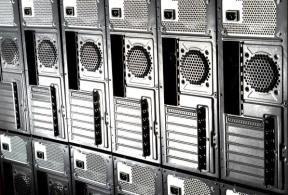 Still these cooling fans, which have lower MTBF compared to electronic components in the host system, are not fail-safe and can malfunction due to a number of reasons. Because of this risk, it’s important to know how critical components, such as oscillators which provide the heartbeat to the system, might behave under fault conditions.
Still these cooling fans, which have lower MTBF compared to electronic components in the host system, are not fail-safe and can malfunction due to a number of reasons. Because of this risk, it’s important to know how critical components, such as oscillators which provide the heartbeat to the system, might behave under fault conditions.
Pushing the limits
To this end, we’ve pushed the limits of various oscillators, measuring stability beyond the rated operating range. We tested TCXO devices that are rated to +85°C and pushed them to +125°C, and tested OCXOs rated to +85°C, up to +105°C. The following plots show the resulting performance degradation at these higher temperatures. In each test we compare a SiTime MEMS oscillator (shown with the green line) to quartz oscillators from various vendors, all within in the same class and with the same temperature rating. To make comparison easier, the values of each device are referred to their frequency at +85°C, beginning at the same point.
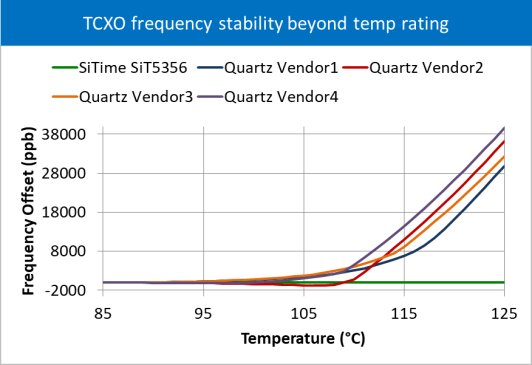
The figure above shows the frequency stability from +85°C to +125°C of five industrial-rated TCXO devices. The MEMS-based SiT5356 Elite Platform™ Super-TCXO demonstrates little degradation. In contrast, the stability of the quartz TCXOs degrades into the tens-of-thousands-ppb range.
Because the frequency offset is so extreme in the quartz oscillators, we show a very wide offset range on the vertical y-axis above. In the figure below we have zoomed-in to show the same test but with a different scale on the y-axis, to better show how stability of the quartz-based devices rapidly degrades just outside the rated temperature range.
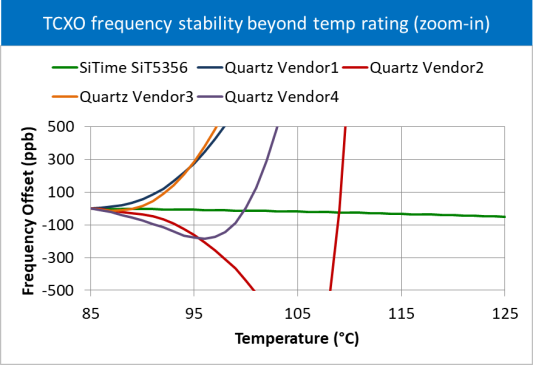
Frequency stability, measured by offset in ppb (parts per billion) as shown above, is a critical performance specification for oscillators. Another important metric for precision oscillators is frequency vs temperature slope (ΔF/ΔT). In systems that require time and frequency transfer using IEEE 1588, better ΔF/ΔT helps improve time error.
The following figure shows the slope (ΔF/ΔT) from +85°C to +125°C for the same five industrial-rated TCXO devices. Again the values are referred to the frequency offset at +85°C. And again the stability of the quartz-based devices rapidly degrades just outside the rated temperature. The rate of frequency change increases from 10 ppb/°C between +85°C and +95°C to almost 3000 ppb/°C at +125°C. In contrast, the MEMS-based SiT5356 shows a slope that’s better than 2 ppb/°C up to +105°C and increases to just 8 ppb/°C at +125°C. The total frequency change from +85°C to 125°C is only 50 ppb.
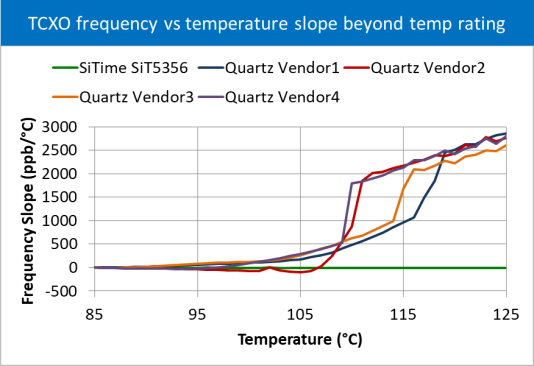
We see similar behavior when testing OCXO devices, as shown in the following plot. Here we compare the performance of four industrial-rated OCXO devices from +85°C to +125°C. The stability of quartz-based devices starts to degrade after the temperature goes above the rated temperature range, while the MEMS-based SiT5711 Emerald Platform™ OCXO maintains stability.
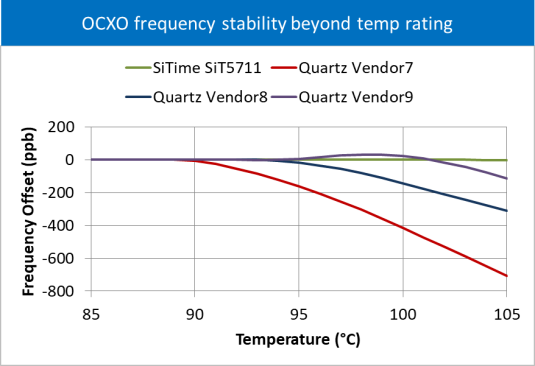
Below we show ΔF/ΔT of the same four industrial-rated OCXO devices from +85°C to +125°C. The frequency slope of the quartz devices degrades up to 30 ppb/°C. In contrast, the MEMS-based SiT5711 OCXO maintains the rated stability up to +105°C with less than 0.5 ppb/°C slope.
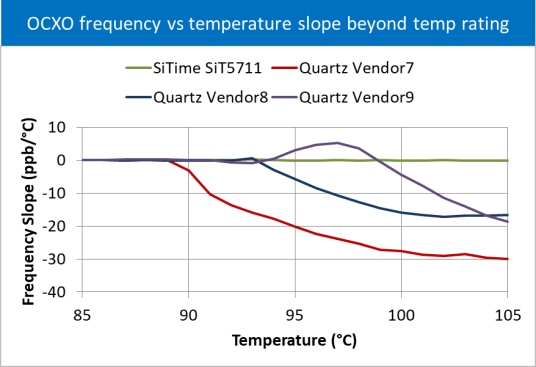
System impact
TCXOs and OCXOs are used in applications such as cellular base stations where a high-stability frequency reference is required. With the possibility of cooling system malfunctions, it’s important to have a timing solution that can withstand high temperatures and maintain system functionality during such events. Besides enduring fault conditions, extended temperature operation of OCXOs and TCXOs can enable systems that are much more robust and reliable, or don’t require cooling fans at all.
Resilience to high heat and other severe conditions is becoming increasingly important in next-generation communications systems as 5G infrastructure is deployed in denser and less-controlled locations. With oscillators that “stay cool” in high heat, SiTime’s timing technology provides the robustness needed for equipment installed in harsh environments.
Download application note AN10063 TCXO and OCXO Stability Degradation for more details, including zoom-in views of each plot above, additional plots with commercial temp-grade TCXOs, and wider sample sets with device-to-device variation data.
………………………………………………………….
Thanks to Anton Prygrodskyi, software engineer at SiTime, for his contributions to this article.
Related blogs
An OCXO that simply works, anywhere
Elite Super-TCXO Family Extends Temperature Support to 105°C
………………………………………………………….
* A TCXO is an oscillator that incorporates temperature compensation to compensate for the frequency vs. temperature characteristic of the resonator. This compensation enables TCXOs to achieve better frequency stability than non-compensated oscillators. Frequency stability of TCXOs ranges from ±0.05 ppm to ±5 ppm. These devices are used in applications where precision timing references are required such as high performance telecom and networking equipment.
** An OCXO provides temperature compensation and ovenization to maintain an almost constant temperature for the oscillator as ambient temperature varies. These devices enclose the resonator, along with temperature-sensing and compensation circuits inside a heated enclosure. This temperature compensation and ovenization enables the OCXO to achieve very good frequency stability ranging from 0.05 ppb to 200 ppb.